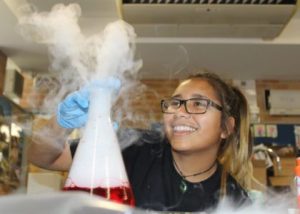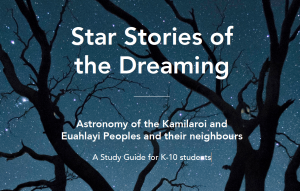Curricula
This page provides teachers and educators with a range of curricula and study guides for teaching Aboriginal Astronomy.
National Curriculum Resources Incorporating Indigenous Astronomy
This project aims to empower all teachers to integrate Aboriginal and Torres Strait Islander perspectives in their teaching. These resources provide engaging examples to assist teachers in implementing the Aboriginal and Torres Strait Islander Histories and Cultures cross-curriculum priority in the classroom. As well as Astronomy, the themes of Fire and Water are also included. The resources can be explored through the homepage’s search function, or by learning area or theme. The resources are tagged by year level, learning area and theme to enable easy navigation. Each resource contains background information about the topic, followed by a classroom activity and references. The classroom activities have been designed to align to the Australian Curriculum (tailored to a specific learning area, year level and content description/s). Be sure to read it carefully (as well as the background information) to ensure it is suitable for the class’ year level and learning area. Teachers should also refer to the Languages page for important information about cultural and linguistic diversity.
Star Stories of the Dreaming: A Study Guide
A Study Guide for K-10 students. The teaching and learning activities in this guide are designed to support quality teaching of Aboriginal perspectives within the NSW K-6 Science Syllabus. Whilst the activities have been created with Stage 2 and 3 students in mind, the content of the guide provides understanding that woul d enrich conversations about Aboriginal histories and cultures, and can be tailored to suit K-10 students.
Stories in the Stars
 Planetarium Show. There are many variations to the stories and cultures of the First Australians. This planetarium show features stories of the night sky of the Boorong people of Victoria. Two Aboriginal teenagers from the city at their family’s Country at Lake Tyrrell in north-west Victoria, they spend a weekend walking around the lake with Grandma and Grandpa, hearing stories about the constellations and how they relate to their culture. This show now features at both the Melbourne Planetarium and Sir Thomas Brisbane Planetarium.
Planetarium Show. There are many variations to the stories and cultures of the First Australians. This planetarium show features stories of the night sky of the Boorong people of Victoria. Two Aboriginal teenagers from the city at their family’s Country at Lake Tyrrell in north-west Victoria, they spend a weekend walking around the lake with Grandma and Grandpa, hearing stories about the constellations and how they relate to their culture. This show now features at both the Melbourne Planetarium and Sir Thomas Brisbane Planetarium.
StarLab Victoria | Scienceworks | Download Flyer | Download Paper
Teacher Resource: Aboriginal Astronomy
 This guide will help students will develop a deeper understanding of Aboriginal astronomy and Dreaming stories about them. Science – Year 3: Science involves making predictions and describing patterns and relationships (ACSHE050). Science – Year 7: Scientific knowledge has changed peoples’ understanding of the world and is refined as new evidence becomes available (ACSHE119). Predictable phenomena on Earth, including seasons and eclipses, are caused by the relative positions of the sun, Earth and the moon (ACSSU115)
This guide will help students will develop a deeper understanding of Aboriginal astronomy and Dreaming stories about them. Science – Year 3: Science involves making predictions and describing patterns and relationships (ACSHE050). Science – Year 7: Scientific knowledge has changed peoples’ understanding of the world and is refined as new evidence becomes available (ACSHE119). Predictable phenomena on Earth, including seasons and eclipses, are caused by the relative positions of the sun, Earth and the moon (ACSSU115)
Embedding Indigenous Science
 Science Years 7-10, from Aboriginal educational contexts, NSW Board of Studies. The main focus of the Aboriginal Perspectives in Science Project has been the development of teaching-learning resources that might assist Science teachers to develop programs emphasising the Aboriginal and Indigenous cross-curriculum content, dealing with it in culturally appropriate ways and in authentic contexts.
Science Years 7-10, from Aboriginal educational contexts, NSW Board of Studies. The main focus of the Aboriginal Perspectives in Science Project has been the development of teaching-learning resources that might assist Science teachers to develop programs emphasising the Aboriginal and Indigenous cross-curriculum content, dealing with it in culturally appropriate ways and in authentic contexts.
Planispheres
 Planispheres – also known as star wheels – are a handy educational tool to show you what it up in the sky at a certain time on a certain date. Two star wheels were developed that feature Kamilaroi and Euahlayi constellations and star names, along with an education brochure. The star wheels are A3 in size and can downloaded as a PDF, printed, then combined with any similar southern hemisphere star wheel of the same size.
Planispheres – also known as star wheels – are a handy educational tool to show you what it up in the sky at a certain time on a certain date. Two star wheels were developed that feature Kamilaroi and Euahlayi constellations and star names, along with an education brochure. The star wheels are A3 in size and can downloaded as a PDF, printed, then combined with any similar southern hemisphere star wheel of the same size.
Brochure (PDF) | Kamilaroi Star Wheel (PDF) | Euahlayi Star Wheel (PDF)
Attribution to Uncle Ghillar Michael Anderson. Goodooga, NSW, Australia
School kids teach themselves Noongar astronomy through self-published book
 A small primary school in Perth is using the oldest stories from the Noongar people to teach year 2 students the wonders of the Universe. The book features Noongar Dreamtime stories. This is not just an acknowledgement of the past, but it highlights the importance of incorporating traditional knowledge into the curriculum at schools like Westminster Primary. It was written by the students themselves, and the kids love being the stars.
A small primary school in Perth is using the oldest stories from the Noongar people to teach year 2 students the wonders of the Universe. The book features Noongar Dreamtime stories. This is not just an acknowledgement of the past, but it highlights the importance of incorporating traditional knowledge into the curriculum at schools like Westminster Primary. It was written by the students themselves, and the kids love being the stars.


